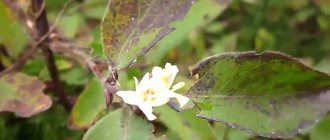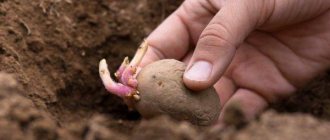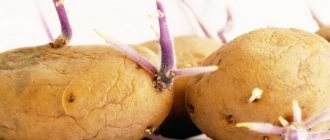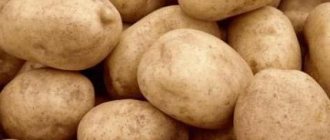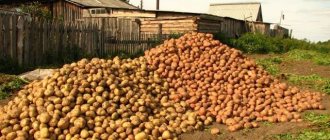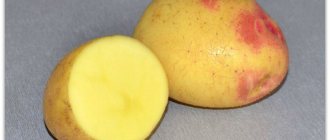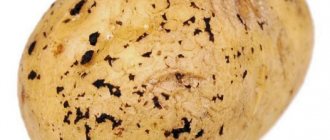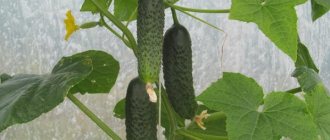Vegetable growing » Potatoes
0
1246
Article rating
Kira Stoletova
The Desiree potato is a variety of Dutch origin, developed for mass cultivation in farmers' fields and has high yields. It is recommended to be planted in southern climates; it is susceptible to fertilizing and a warm environment.
Description of the Desiree potato variety
Potatoes “Desiree”: variety description, photo
| Variety name | Desiree |
| general characteristics | universal mid-season potato variety of Dutch selection with high starch content |
| Maturation period | 80-95 days |
| Starch content | 13,5-21,5% |
| Weight of marketable tubers | 50-100 gr |
| Number of tubers in a bush | 18-20 |
| Productivity | 130-380 c/ha |
| Consumer qualities | good taste, the flesh does not darken when cut, suitable for baking, mashing, stewing and frying |
| Keeping quality | 95% |
| Peel color | red |
| Flesh color | light yellow |
| Preferred Growing Regions | Middle Volga |
| Disease resistance | resistant to potato cancer and viral diseases, affected by golden nematode, fomosis and scab |
| Features of cultivation | The variety does not tolerate soil frosts well, responds well to fertilizing and watering, and is drought-resistant. |
| Originator | HZPC HOLLAND BV (Netherlands) |
- small tubers, weighing up to 100 g;
- oval shape;
- tubers are smooth, neat, even in size;
- the peel is red, evenly colored, dense;
- ocelli superficial, shallow, few in number;
- the pulp is light yellow when cut;
- starch content ranges from 13.5 to 21.5%;
- high content of protein, mineral salts, amino acids, carotene.
To compare the characteristics of Desiree with other potato varieties, take a look at the table below:
| Variety name | Starch content | Keeping quality |
| Desiree | 13,5-21,5% | 95% |
| Openwork | 14-16% | 95% |
| Santana | 13-17% | 92% |
| Nevsky | 10-12% | good, but the tubers germinate early |
| Ramos | 13-16% | 97% |
| Taisiya | 13-16% | 96% (tubers have a long dormant period) |
| Lapot | 13-16% | 94% |
| Rodrigo | 12-15% | 95% (not subject to freezing) |
Diseases and pests
Desiree potato variety:
- Does not affect potato cancer and viral diseases;
- Not resistant to common scab, Phoma, late blight of leaves;
- Immune to tuber blight.
Necessary preventive measures:
- Carefully select planting material;
- Regularly change planting areas. During the rest period, sow the beds with oilseed radish ;
- Conduct pre-planting treatment of fields with herbicides;
- During the late blight epidemic, potato plantings are sprayed with copper-containing preparations;
- To prevent the appearance of Colorado potato beetles and their larvae, wireworms, mole crickets and potato moths, the bushes are treated with insecticides.
Characteristics
The “Desiree” variety, a rather large potato, belongs to the mid-season table potatoes and has its own distinctive characteristics. The first tubers can be dug up in mid-summer , but the main harvest occurs in the second half of September. It is better to plant tubers when the soil is completely warm; spring frosts can have a bad effect on the yield.
Medium sized bush, moderately spreading. The formation of green mass is moderate. The leaves are matte, dark green, medium-sized, slightly wavy. Reddish-purple flowers are collected in a compact corolla, the berries are few. The root system is powerful, each bush produces up to 20 large, even tubers. The amount of non-commercial small items is insignificant.
Potatoes are characterized by increased productivity . On poor soils it is about 130 centners per hectare; with fertilizing and more favorable weather conditions it can reach up to 380 centners.
The table below presents data on the yield of other potato varieties for comparison:
| Variety name | Productivity |
| Desiree | 130-380 c/ha |
| Crown | 430-650 c/ha |
| Lily | up to 670 c/ha |
| American | 250-420 c/ha |
| Handsome | 170-280 c/ha |
| Blue Danube | 350-400 c/ha |
| Palm | up to 450 c/ha |
| Typhoon | 400-450 c/ha |
| Jelly | up to 550 c/ha |
| Gourmet | 350-400 c/ha |
| Red Fantasy | 260-380 c/ha |
Read more about how to feed potatoes, when and how to apply fertilizers, and how to do it correctly when planting.
The tubers have good immunity , do not degenerate, and seed material can be collected from your own fields from year to year.
Desiree potatoes are ideal for the southern regions. It can easily tolerate hot, dry summers, but several waterings and hilling will significantly increase the yield. Potatoes need light sandy soils with neutral acidity and love mineral or organic fertilizers.
The Desiree variety is resistant to tuber late blight, potato canker, fomoz, and viral diseases. May be susceptible to leaf blight, blossom end or root rot. The thick peel protects the tubers well from mechanical damage and insect larvae. This is the characteristic of the Desiree potato.
The taste of potatoes is excellent . The pulp is tender, crumbly, not watery, with light sweet notes. Depending on the starch content, the tubers can be used for mashing, boiling, baking, and stewing. When cutting and cooking, root vegetables do not darken, maintaining a beautiful yellowish tint.
The variety is suitable for making French fries and chips (including in industrial conditions).
Collection, storage and use of crops
The first tubers ripen by mid-summer, but the mass harvest occurs in September. Two days before harvest, the tops are mowed. It is not advisable to leave it on the field, as pests that can harm the tubers may remain in it.
After digging the potatoes out of the ground, they are left in the sun for several hours to dry. If the sun is bright and scorching, a canopy should be provided.
After drying, the potatoes are placed in wooden boxes and sent to a dry, cool room for further storage. They are also used for transportation to any distance.
Thanks to their excellent sweetish taste and non-watery structure, potatoes are used in a variety of ways in cooking: baked, boiled, fried, stewed with other vegetables and meat, and used as a filling for pies. The friability of vegetables allows you to get a tasty and airy puree.
In addition to home cooking, potatoes are used in mass production for the preparation of semi-finished products and chips.
Origin of the variety
The Desiree potato variety was bred by Dutch breeders. Included in the State Register of the Russian Federation in 1997. Zoned for the Middle Volga region.
Recommended for growing in areas with warm climates . Potatoes can easily tolerate heat and short-term drought, but are sensitive to frost. Prefers fertile light soil; in poor clay soil the yield is noticeably reduced.
The variety is suitable for industrial cultivation; harvested potatoes can be stored for several months without losing commercial quality. Large, smooth tubers are ideal for sale; transportation over long distances is possible. The Desiree variety can be a good basis for breeding work. The tubers do not degenerate; seed material for subsequent plantings can be collected independently.
We bring to your attention useful materials about the medicinal properties of potatoes. Read about the benefits and harms of raw potatoes, why sprouts and juice are eaten, and why solanine is dangerous for the human body.
Step-by-step instructions for growing
Potatoes prefer light soils with neutral acidity . 2-3 feedings and hilling help increase productivity.
Inventory
For garden plots, you will need a standard set for maintenance - a shovel, a pitchfork, a hoe, a rake. For watering, use a hose or sprinkler-type irrigation system. When growing on an industrial scale, you will need special equipment:
- Cultivator, walk-behind tractor - for hilling, loosening.
- Potato planter - for planting.
- Plow, harrow - for preparing beds.
- Combines - for harvesting.
- Watering devices - for irrigation.
Preparation of soil and planting material
The soil and tubers are prepared for planting using traditional methods . For root crops, disinfection, stimulation, and germination are carried out. The soil is fertilized in the fall and on the eve of planting.
Soils
Tubers are planted in fertile light soil. To do this, in the fall they add humus, compost, peat, phosphorus-potassium minerals, and dig to a bayonet depth.
After the snow melts, the area is harrowed or disked. When planting, add the following to the holes:
- 1 tbsp. wood ash.
- 1 handful of rotted compost.
- 8-10 g of phosphorus-potassium supplement.
Planting material
After the autumn harvest, intact, smooth seed tubers the size of a chicken egg are selected. Germination begins a month before the planned planting :
- Spoiled root crops are discarded.
- Seed tubers are laid out in 2-3 layers.
- Maintain a temperature of 14-15 degrees.
- Provide sufficient lighting.
To activate germination, soak in:
Timing
Planting begins in the Middle Volga region - Penza, Orenburg, Samara, Ulyanovsk, in the initial 2 weeks of May. Planting lasts until early June. In the south - in the Krasnodar region, Crimea, planting begins in the second half of April.
Adheres to such temperature stabilization indicators:
- For air 13-14 degrees.
- For soil 8-10 degrees.
Planting scheme
Maintain the following distances:
- Between rows 75 cm.
- Between pits 35 cm.
The depth depends on the type of soil - on light soils 9-10 cm, on loams 5-7 cm.
Cultivation is carried out in the same way as for other mid-season varieties . Standard care - irrigation, hilling and weeding, disease prevention and pest control. Particular attention is paid to fertilizing to increase productivity.
Hilling
Bushes are hilled 2-3 times per season.
Dates :
- With a shoot height of 10-12 cm.
- Before flowering.
- With a tops length of 30-35 cm, before lowering to the ground.
The frequency of hilling is once every 14-16 days.
Watering
Desiree cannot tolerate excess moisture, due to which she is quickly affected by rot and other fungi. One watering for the entire period is enough . During the long dry season, 2-3 irrigations are allowed.
Loosening
The first time is loosened before the emergence of shoots - 5-7 days after planting. This prevents the germination of weeds and breaks the crust on the surface.
Weeding
The procedure is carried out 3-4 times per season, combined with hilling. Particular attention is paid to pulling out nightshade weeds, sources of pathogenic fungi.
Top dressing
Fertilizers are applied for the first time 2 weeks after germination . Use compost, humus, ash, urea or saltpeter. Good results are obtained from herbal bioinfusions. During budding, superphosphate and potassium salts are included.
During or immediately after flowering, fertilize the bushes 3 times. Dilute 2 tbsp in 10 liters. superphosphate and 200 g mullein. 500 ml is poured under 1 plant.
Other care measures
Potatoes bear fruit better in mulched beds . Among the main functions of mulch are preventing moisture loss, getting rid of weeds, and reducing the risk of infection.
Preference is given to organic:
Advantages and disadvantages
Among the main advantages of the Desire variety:
- high taste qualities of root vegetables;
- versatility;
- good yield;
- drought resistance;
- there is little defect, the tubers have a beautiful appearance;
- suitable for preparing various dishes and ready-made products;
- the harvested crop is well stored and transported;
- Can be grown on an industrial scale;
- resistance to many diseases.
Read more about the storage time and temperature of potatoes, and about possible problems. And also about how to properly store root vegetables in winter, in boxes and on the balcony, in the refrigerator and peeled.
The variety also has disadvantages . These include:
- susceptibility to scab, fomosis and late blight;
- tubers do not tolerate frost or excess moisture;
- The thick peel makes cutting the root vegetables difficult.
Productivity
Let's consider the yield characteristics of the Tiras potato. The variety is suitable for obtaining two harvests. Belongs to mid-early varieties.
From the emergence of seedlings to technical ripeness, 70-80 days pass. In the coldest regions, the variety ripens in 90 days. The growing season lasts 60-65 days. Fruit formation occurs 10-15 days after planting.
The harvest is harvested 38-42 days after the first shoots. 210 centners of fruits are harvested from 1 hectare. At the end of the growing season, the total yield reaches 460 centners per hectare.
The yield of marketable tubers is 93%. The variety has excellent keeping quality. It can be stored in cool vegetable stores for more than 5 months. Has a table purpose. Taste qualities are rated 3.7-4.0 points out of 5.
Read more about the storage time and temperature of potatoes, and about possible problems. And also about storing it in winter, in boxes, on the balcony, in the refrigerator, cleaned.
You can compare the yield and keeping quality of a variety with others using the table below:
| Variety name | Productivity (c/ha) | Keeping quality(%) |
| Tiras | 210-460 | 93 |
| Serpanok | 170-215 | 94 |
| Elmundo | 250-345 | 97 |
| Milena | 450-600 | 95 |
| League | 210-360 | 93 |
| Vector | 670 | 95 |
| Mozart | 200-330 | 92 |
| Sifra | 180-400 | 94 |
| Queen Anne | 390-460 | 92 |
The variety is responsive to fertilizing. Read more about how to fertilize potatoes, when and how to fertilize, and how to do it correctly when planting.
It is recommended to remove the tops two weeks before harvest. It is harvested from both seed and food bushes. This procedure accelerates the ripening of fruits. This method also prevents the re-infection of viral diseases by carriers.
Features of cultivation
Agricultural technology for this variety is simple. Tubers are planted when the soil is completely warm; spring frosts can destroy the plants. Before planting, the seed is treated with disinfectants and growth stimulants. Disinfection is necessary, since tubers can be affected by fungal diseases.
Planting is carried out according to the standard scheme . The distance between bushes is 35 cm, row spacing is 75 cm. When planting, it is recommended to add humus or wood ash to the holes. It is possible to use mineral complexes containing urea or ammonium nitrate, superphosphate, and potassium sulfate. During the planting season, you need to hill up at least 2 times; single watering is recommended. Mulching between rows can be used to control weeds.
It is better to dig up tubers at the end of the growing season; 2-3 days before harvesting, it is recommended to cut off all the tops.
Potatoes are well dried before storage . It is better to select tubers damaged during digging and not put them in the cellar. Seed material is collected from the highest-yielding and strongest bushes; it must be stored separately. For planting, you can use both whole potatoes and segments with eyes.
There are many ways to grow potatoes. We have prepared a lot of interesting information on this topic for you. Read all about modern Dutch technologies, about growing early varieties and getting a harvest without weeding and hilling.
Explore unusual ways to grow root vegetables under straw, in barrels, in bags, in boxes.
Desire – Villa Desire
- Beds: 5
- Bathrooms: 3
- Floors: 0
- Parking:
- Ref #: Desire
- Type: Rent
- Category: Exclusive rentals Sardinia
The villa is very elegant with special attention to detail, has direct access to the sea, a comfortable equipped rocky beach. Ground floor - entrance, living room, fully equipped kitchen, outdoor area and terrace around the pool, bedroom with bathroom with shower, patio with dining area Garden level - three double bedrooms with en-suite bathrooms and laundry room, which can be furnished as a staff bedroom for two with bathroom with shower. Nearest airport: Olbia Distance to airport: 25 min by car Distance to port: 3 min by car Distance to sea: direct access Distance to golf club: 30 min by car
Nearest airport: Olbia Distance to airport: 25 min by car Distance to port: 3 min by car Distance to sea: direct access Distance to golf club: 30 min by car
Equipment:Parking 4JacuzziSwimming pool 100 m2DVDWiFiGarden 5000 mSafeAir conditioning
